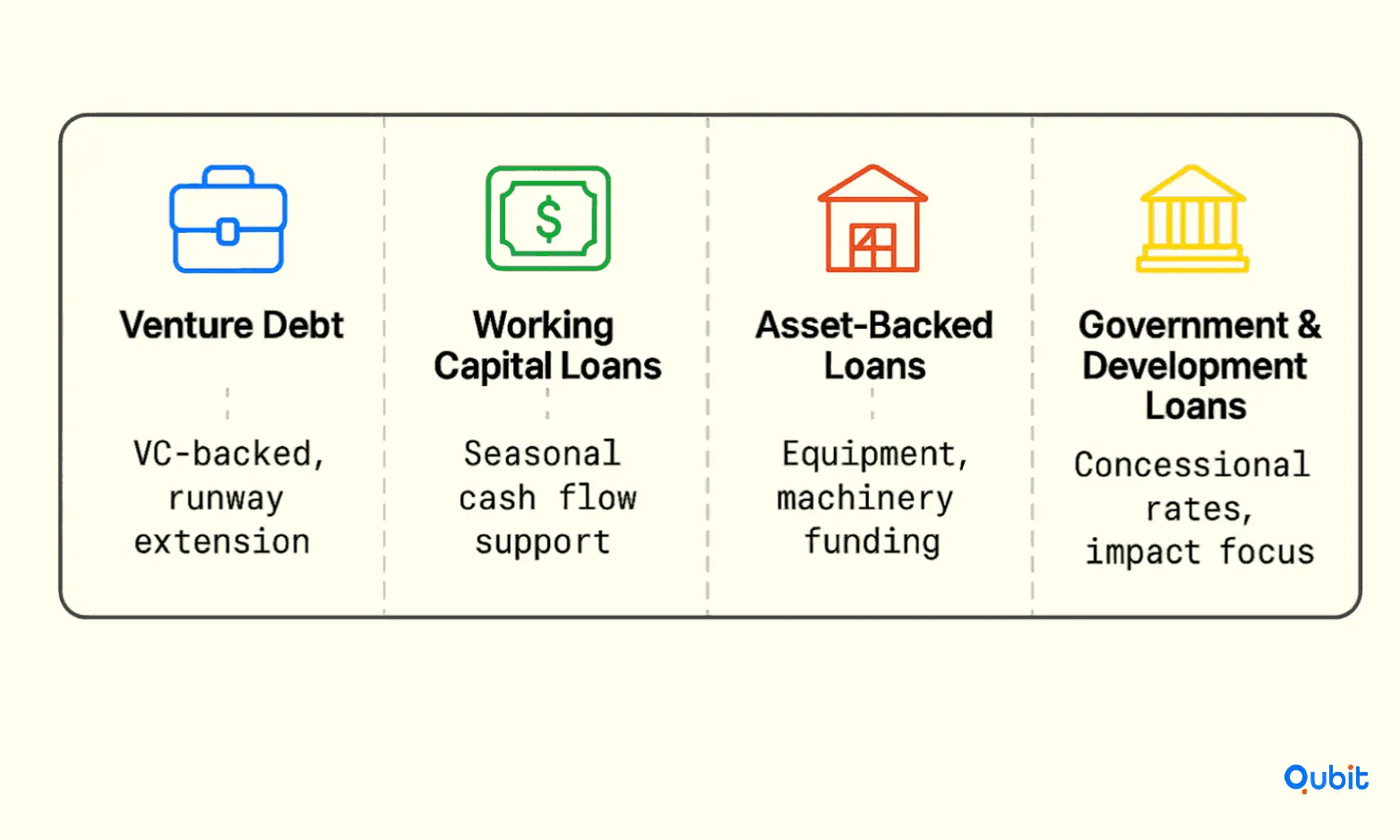As AgriTech startups mature from early pilots to commercial scale, access to growth capital becomes critical. While equity funding—through venture capital, angels, and corporate investors, remains a mainstay, debt financing is increasingly recognized as a powerful, non-dilutive tool for AgriTech scale-ups. The right debt structure can help founders preserve equity, manage working capital, accelerate expansion, and bridge funding gaps between equity rounds.
This comprehensive guide explores the debt financing landscape for AgriTech scale-ups in 2025. We’ll cover the types of debt available, eligibility criteria, lender expectations, pros and cons, and actionable strategies to help you secure and manage debt effectively.
Why Debt Financing for AgriTech Scale-Ups?
The Equity Dilemma
Equity capital is vital for early-stage innovation, team building, and product-market fit. However, as AgriTech startups scale, excessive reliance on equity can lead to significant dilution for founders and early investors. Debt financing allows companies to access growth capital without giving up ownership or control.
The Growth Imperative
AgriTech scale-ups often face capital-intensive scaling: manufacturing, supply chain, inventory, R&D, and market expansion. Debt can fund these needs more efficiently than equity, especially when the business model generates predictable revenue or asset value.
Bridging Funding Gaps
Debt can serve as a bridge between equity rounds, providing runway to hit key milestones and achieve higher valuations in future raises.
Types of Debt Financing for AgriTech Startups

Venture Debt
Definition:
Venture debt is a medium-term loan designed for startups that have raised venture capital and are in high-growth mode. It’s typically structured as a term loan with a 2–4 year maturity, often including warrants or small equity kickers.
When to Use:
- Post-seed or Series A/B, when you have VC backing and need to extend runway or fund growth.
- As a complement to equity, not a replacement.
Providers:
- Specialized venture debt funds (e.g., Caspian Debt, Trifecta, InnoVen Capital in India; Silicon Valley Bank, Hercules Capital globally).
- Some commercial banks with startup arms.
Key Features:
- Loan amount: typically 20–40% of last equity round or current cash balance.
- Tenor: 2–4 years, often with an interest-only period.
- Warrants: Lenders may ask for small equity warrants (1–2%).
- Collateral: Often unsecured, but may require IP, inventory, or receivables as security.
- Covenants: Financial or operational covenants may apply.
Pros:
- Preserves equity and founder control.
- Fast, flexible, and less intrusive than equity.
- Can improve company valuation for next round.
Cons:
- Requires repayment regardless of business performance.
- May include restrictive covenants.
- Not suitable for pre-revenue or very early-stage startups.
Working Capital Loans
Definition:
Short-term loans or lines of credit to finance day-to-day operations, inventory, or receivables.
When to Use:
- Seasonal cash flow needs (e.g., harvest cycles, input purchases).
- Managing payables and receivables.
Providers:
- Commercial banks (public and private sector).
- NBFCs and fintech lenders.
- Specialized AgriTech funds (e.g., Caspian Debt’s Agri Impact Fund).
Key Features:
- Collateral: May be secured (inventory, receivables) or unsecured.
- Tenor: 6–24 months.
- Flexible drawdown and repayment.
Pros:
- Supports operational liquidity.
- Often quick to arrange if you have strong banking relationships.
Cons:
- May require personal guarantees or hard collateral.
- Interest rates can be higher for unsecured loans.
Asset-Backed Loans
Definition:
Loans secured against physical assets: equipment, machinery, vehicles, or property.
When to Use:
- Financing expansion of manufacturing, logistics, or technology infrastructure.
- Equipment leasing or purchase.
Providers:
Key Features:
- Loan-to-value ratio: typically 60–80% of asset value.
- Tenor: 3–7 years.
- Fixed or floating interest rates.
Pros:
- Lower interest rates due to collateral.
- Suitable for capital-intensive AgriTech models.
Cons:
- Risk of asset repossession if you default.
- Not suitable for asset-light SaaS or digital AgriTech startups.
Receivables and Invoice Financing
Definition:
Short-term advances against outstanding invoices or future receivables.
When to Use:
- Bridging payment cycles from large buyers, government contracts, or B2B customers.
Providers:
- Banks, NBFCs, fintech platforms.
Key Features:
- Advance: 70–90% of invoice value.
- Repayment: On invoice settlement.
- Fees: Discount rate or interest on advance.
Pros:
- Improves cash flow without taking on long-term debt.
- No equity dilution.
Cons:
- Only available if you have large, creditworthy customers.
- Can be expensive if used frequently.
Government and Development Bank Loans
Definition:
Loans or credit lines offered by government agencies or multilateral banks to promote AgriTech, rural development, or sustainability.
When to Use:
- Expansion into priority sectors (climate resilience, food security, digital inclusion).
- Projects aligned with government or donor objectives.
Providers:
Key Features:
- Concessional interest rates.
- Longer tenors.
- May come with technical assistance or grant components.
Pros:
- Lower cost of capital.
- Supports impact-driven AgriTech models.
Cons:
- Application and approval can be slow and bureaucratic.
- May require extensive reporting and compliance.
Eligibility Criteria and Lender Expectations
What Lenders Look For
- Revenue and Growth: Predictable revenue streams, strong growth trajectory, and a clear path to profitability.
- Backer Quality: Venture debt lenders may consider the quality of your VC investors, but this is less critical than before.
- Collateral: Inventory, equipment, IP, or receivables. Some lenders offer collateral-free loans for high-growth AgriTechs.
- Current Ratio: Typically >1.5 (current assets/current liabilities).
- Debt Service Coverage Ratio (DSCR): Operating income should cover at least 1.25x debt payments.
- Business Plan: Clear use of funds, financial projections, and risk mitigation strategies.
- Credit History: While traditional credit scores matter less for venture debt, a track record of responsible financial management is key.
Common Covenants
- Financial Covenants: Minimum liquidity, leverage ratios, or revenue targets.
- Operational Covenants: Restrictions on asset sales, new debt, or major business changes.
- Reporting Requirements: Regular updates on financials, KPIs, and compliance.
Pros and Cons of Debt Financing for AgriTech Scale-Ups
Pros
- Non-Dilutive: Founders retain more ownership and control.
- Faster Access: Debt can be arranged more quickly than equity rounds.
- Flexible Use: Can fund working capital, expansion, R&D, or inventory.
- Valuation Uplift: Bridge to next equity round at a higher valuation.
- Signaling Effect: Securing debt from reputable lenders can boost credibility with future investors.
Cons
- Repayment Obligation: Debt must be repaid regardless of business performance.
- Covenants and Restrictions: May limit operational flexibility.
- Collateral Risk: Default can result in asset loss.
- Not for All: Early-stage, pre-revenue, or asset-light startups may not qualify.
How to Prepare for Debt Financing
Assess Your Capital Needs
- Define the purpose: working capital, equipment, expansion, or bridge to equity.
- Calculate the amount needed and repayment capacity.
Build a Strong Financial Profile
- Maintain clean, audited financials.
- Track key metrics: revenue, margins, cash flow, and DSCR.
- Prepare detailed forecasts and scenarios.
Strengthen Your Collateral Base
- Inventory, equipment, IP, and receivables can all be pledged.
- For SaaS or digital AgriTech, highlight recurring revenue and customer contracts.
Shop for the Right Lender
- Compare terms, interest rates, fees, and covenants.
- Consider specialized AgriTech lenders (e.g., Caspian Debt’s Agritech Fund), banks, NBFCs, and development banks.
Negotiate Terms
- Seek flexibility on repayment, covenants, and collateral.
- Clarify any equity kicker or warrant requirements for venture debt.
Debt Financing in Practice: Case Studies
Case Study 1: Venture Debt for a Precision AgriTech Scale-Up
A precision agriculture startup with $3M ARR and Series A VC backing secured a $1M venture debt facility to fund expansion into new markets. The loan was structured with a 3-year tenor, interest-only for the first 12 months, and a small equity warrant. The capital enabled the company to scale sales without diluting founders.
Case Study 2: Working Capital for Agri Input Marketplace
An AgriTech marketplace serving smallholder farmers used a $500,000 working capital line to manage seasonal inventory purchases. The facility was secured against receivables and repaid over 9 months as sales were realized.
Case Study 3: Asset-Backed Loan for Agri Processing
A post-harvest startup secured a 5-year, $2M loan to purchase new processing equipment. The loan was collateralized by the equipment itself, with repayments structured to match seasonal cash flows.
Case Study 4: Government-Backed Loan for Climate-Smart AgriTech
A company developing IoT sensors for climate resilience accessed a $750,000 concessional loan from a development bank. The loan supported R&D and pilot deployments, with a 5-year term and below-market interest rate.
Strategic Considerations: When and How to Use Debt
When to Use Debt
- Bridge to Equity: Between rounds, to hit milestones and raise at a higher valuation.
- Scaling Operations: For inventory, equipment, or market expansion.
- Working Capital: To smooth cash flow in seasonal businesses.
- Leverage: To amplify returns when revenue is predictable.
When to Avoid Debt
- Pre-Revenue: If you lack predictable cash flow or collateral.
- High Burn: If your business is not yet profitable or close to breakeven.
- Excessive Leverage: If you already have significant debt on your balance sheet.
Blending Debt with Equity
- Use debt to minimize dilution and maximize founder returns.
- Combine with equity for major growth initiatives or acquisitions.
- Explore hybrid instruments (convertible debt, revenue-based financing).
Alternative and Non-Dilutive Funding Options
- Government Grants and Subsidies: Non-repayable funds for R&D, sustainability, or rural development.
- Crowdfunding: Campaigns for product launches or community-driven projects.
- Corporate Partnerships: Joint ventures or revenue-sharing agreements.
- Receivables Financing: For companies with large, creditworthy customers.
Many agri/foodtech ventures overlook non-equity paths, but how to secure funding for agritech & foodtech startups walks through grants, revenue-based finance, and other alternative models that keep your cap table intact.
How Debt Financing Fits into the AgriTech Growth Journey
Early-Stage
- Equity, grants, and bootstrapping are primary sources.
- Debt is rare unless revenue is predictable or collateral is available.
Scale-Up Stage
- Venture debt and working capital loans become viable as revenue grows.
- Asset-backed and receivables financing support expansion.
Late-Stage and Pre-IPO
- Larger, syndicated debt facilities or structured finance.
- Used for acquisitions, international expansion, or pre-IPO bridge.
Charting growth beyond seed requires hitting specific milestones—preparing for series a & b in agritech maps the traction metrics, valuation checkpoints, and investor signals you need to lock in those rounds.
Common Mistakes and How to Avoid Them
- Overleveraging: Don’t take on more debt than your cash flow can support.
- Ignoring Covenants: Understand and manage all loan covenants to avoid default.
- Mismatched Tenor: Align loan terms with the asset or project lifespan.
- Lack of Communication: Keep lenders informed of business developments.
- Underestimating Costs: Factor in interest, fees, and potential equity dilution from warrants.
Conclusion
Debt financing is no longer just a fallback for AgriTech scale-ups, it’s a strategic lever for founders seeking to grow faster, preserve equity, and build resilient, capital-efficient businesses. By understanding the options, preparing thoroughly, and aligning debt with business goals, AgriTech leaders can unlock new growth while maintaining control and flexibility.
Debt financing is a powerful tool for AgriTech scale-ups—but only if you structure it right and pitch to the right lenders. Don’t risk costly missteps or wasted time. Our Fundraising Assistance service gives you expert, sector-specific support to navigate funding options, build a compelling case for lenders, and secure the capital you need to take your AgriTech business to the next level in 2025.
Key Takeaways
- Debt financing is a powerful, non-dilutive tool for AgriTech scale-ups, enabling growth without sacrificing ownership.
- Venture debt, working capital, asset-backed, and government loans each have unique benefits and requirements.
- Preparation is key: Maintain strong financials, understand lender expectations, and negotiate favorable terms.
- Blend debt with equity and alternative funding to optimize your capital stack and minimize dilution.
- Strategic use of debt can bridge funding gaps, accelerate growth, and improve valuation for future equity rounds.
Frequently asked Questions
What is venture debt, and how is it different from a bank loan?
Venture debt is tailored for VC-backed, high-growth startups. It’s more flexible, often unsecured, and complements equity funding—while traditional bank loans require hard collateral and profitability






